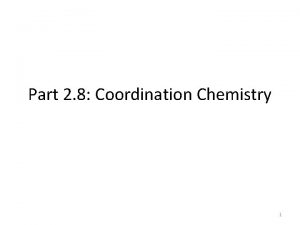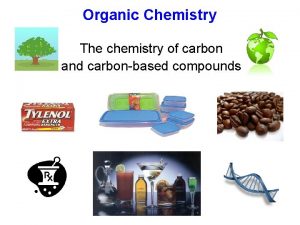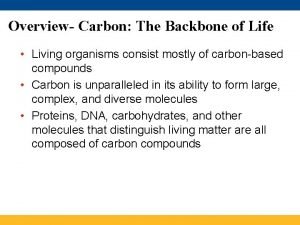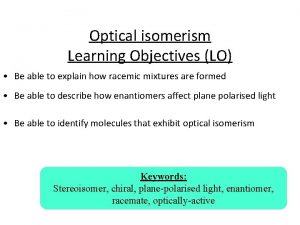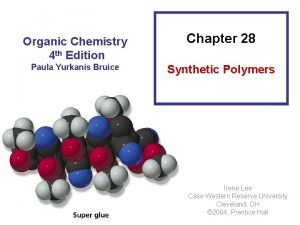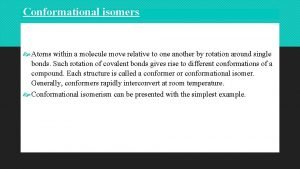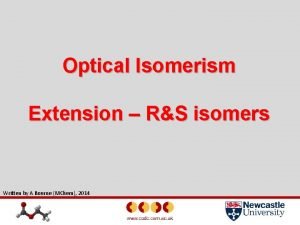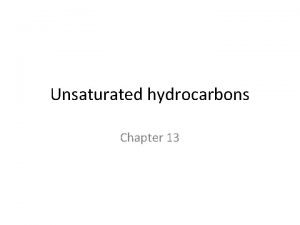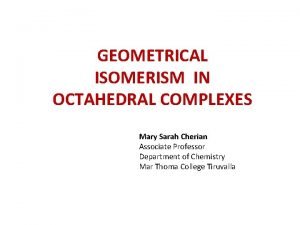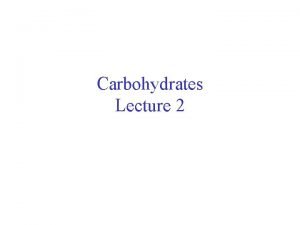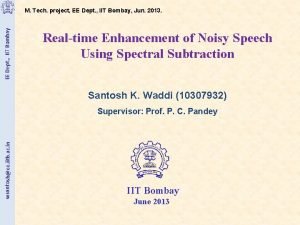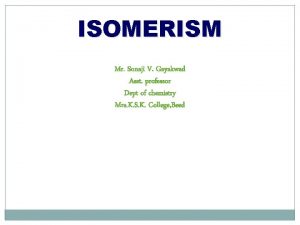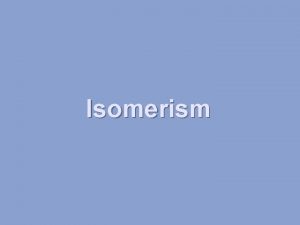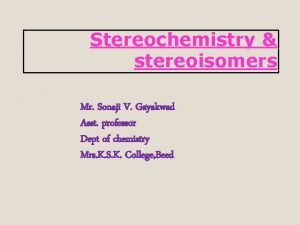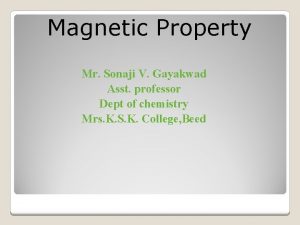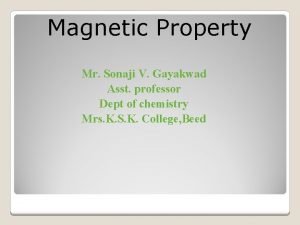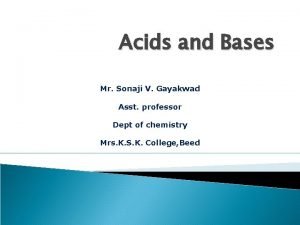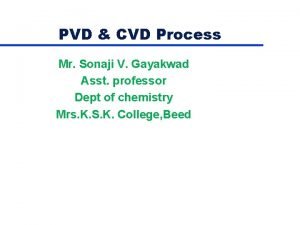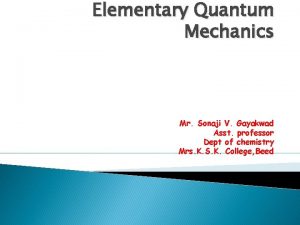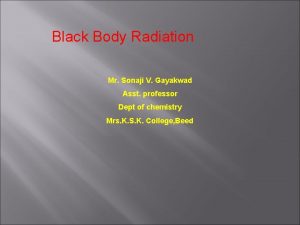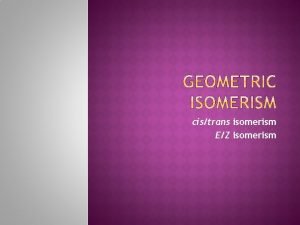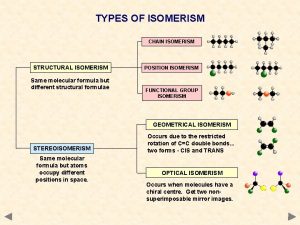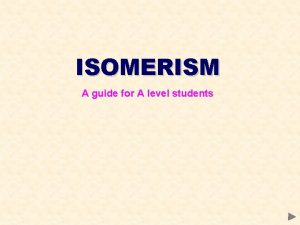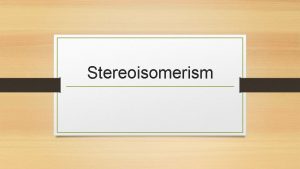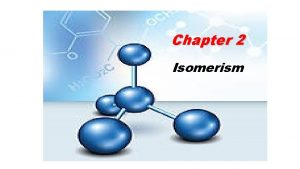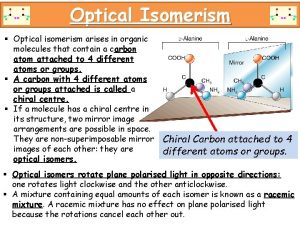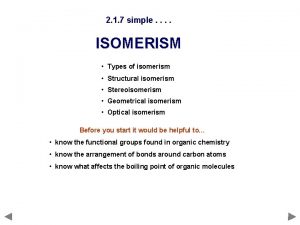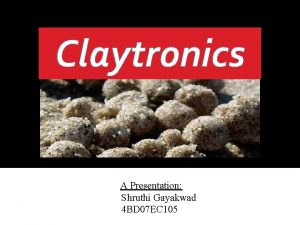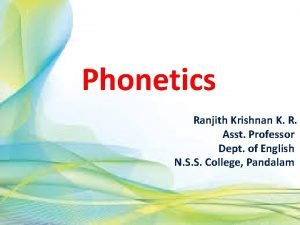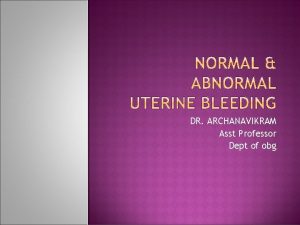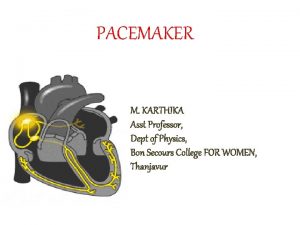ISOMERISM Mr Sonaji V Gayakwad Asst professor Dept




































- Slides: 36

ISOMERISM Mr. Sonaji V. Gayakwad Asst. professor Dept of chemistry Mrs. K. S. K. College, Beed

KNOCKHARDY PUBLISHING ISOMERISM INTRODUCTION This Powerpoint show is one of several produced to help students understand selected topics at AS and A 2 level Chemistry. It is based on the requirements of the AQA and OCR specifications but is suitable for other examination boards. Individual students may use the material at home for revision purposes or it may be used for classroom teaching using an interactive white board. Accompanying notes on this, and the full range of AS and A 2 topics, are available from the KNOCKHARDY SCIENCE WEBSITE at. . .

ISOMERISM CONTENTS • Prior knowledge • Types of isomerism • Structural isomerism • Stereoisomerism • Geometrical isomerism • Optical isomerism • Check list

ISOMERISM Before you start it would be helpful to… • know the functional groups found in organic chemistry • know the arrangement of bonds around carbon atoms • know what affects the boiling point of organic molecules

TYPES OF ISOMERISM CHAIN ISOMERISM STRUCTURAL ISOMERISM Same molecular formula but different structural formulae POSITION ISOMERISM FUNCTIONAL GROUP ISOMERISM GEOMETRICAL ISOMERISM STEREOISOMERISM Same molecular formula but atoms occupy different positions in space. Occurs due to the restricted rotation of C=C double bonds. . . two forms… E and Z (CIS and TRANS) OPTICAL ISOMERISM Occurs when molecules have a chiral centre. Get two nonsuperimposable mirror images.

STRUCTURAL ISOMERISM - INTRODUCTION COMPOUNDS HAVE THE SAME MOLECULAR FORMULA BUT DIFFERENT STRUCTURAL FORMULA Chain different arrangements of the carbon skeleton similar chemical properties slightly different physical properties more branching = lower boiling point

STRUCTURAL ISOMERISM - INTRODUCTION COMPOUNDS HAVE THE SAME MOLECULAR FORMULA BUT DIFFERENT STRUCTURAL FORMULA Chain different arrangements of the carbon skeleton similar chemical properties slightly different physical properties more branching = lower boiling point Positional same carbon skeleton same functional group is in a different position similar chemical properties - slightly different physical properties

STRUCTURAL ISOMERISM - INTRODUCTION COMPOUNDS HAVE THE SAME MOLECULAR FORMULA BUT DIFFERENT STRUCTURAL FORMULA Chain different arrangements of the carbon skeleton similar chemical properties slightly different physical properties more branching = lower boiling point Positional same carbon skeleton same functional group is in a different position similar chemical properties - slightly different physical properties Functional Group different functional group different chemical properties different physical properties • Sometimes more than one type of isomerism occurs in the same molecule. • The more carbon atoms there are, the greater the number of possible isomers

STRUCTURAL ISOMERISM - CHAIN caused by different arrangements of the carbon skeleton similar chemical properties slightly different physical properties more branching = lower boiling point There are two structural isomers of C 4 H 10. One is a straight chain molecule where all the carbon atoms are in a single row. The other is a branched molecule where three carbon atoms are in a row and one carbon atom sticks out of the main chain. BUTANE straight chain 2 -METHYLPROPANE branched C 4 H 10

STRUCTURAL ISOMERISM - CHAIN DIFFERENCES BETWEEN CHAIN ISOMERS Chemical Isomers show similar chemical properties because the same functional group is present. Physical Properties such as density and boiling point show trends according to the of the degree of branching Boiling Point “straight” chain isomers have higher values than branched ones the greater the degree of branching the lower the boiling point branching decreases the effectiveness of intermolecular forces less energy has to be put in to separate the molecules - 0. 5°C straight chain - 11. 7°C branched greater branching = lower boiling point

STRUCTURAL ISOMERISM - POSITIONAL molecule has the same carbon skeleton molecule has the same functional group. . . BUT the functional group is in a different position have similar chemical properties / different physical properties Example 1 POSITION OF A DOUBLE BOND IN ALKENES 1 2 PENT-1 -ENE double bond between carbons 1 and 2 2 3 PENT-2 -ENE double bond between carbons 2 and 3 There are no other isomers with five C’s in the longest chain but there are three other structural isomers with a chain of four carbons plus one in a branch.

STRUCTURAL ISOMERISM - POSITIONAL molecule has the same carbon skeleton molecule has the same functional group. . . BUT the functional group is in a different position have similar chemical properties / different physical properties Example 2 POSITION OF A HALOGEN IN A HALOALKANE 1 1 -CHLOROBUTANE halogen on carbon 1 2 2 -CHLOROBUTANE halogen on carbon 2 BUT 2 is NOT 3 -CHLOROBUTANE Moving the chlorine along the chain makes new isomers; the position is measured from the end nearest the functional group. . . the third example is 2 - NOT 3 -chlorobutane. There are 2 more structural isomers of C 4 H 9 Cl but they have a longest chain of 3

STRUCTURAL ISOMERISM - POSITIONAL molecule has the same carbon skeleton molecule has the same functional group. . . BUT the functional group is in a different position have similar chemical properties / different physical properties Example 3 RELATIVE POSITIONS ON A BENZENE RING 1, 2 -DICHLOROBENZENE ortho dichlorobenzene 1, 3 -DICHLOROBENZENE meta dichlorobenzene 1, 4 -DICHLOROBENZENE para dichlorobenzene

STRUCTURAL ISOMERISM – FUNCTIONAL GROUP molecules have same molecular formula molecules have different functional groups molecules have different chemical properties molecules have different physical properties ALCOHOLS and ETHERS ALDEHYDES and KETONES ACIDS and ESTERS MORE DETAILS FOLLOW

STRUCTURAL ISOMERISM – FUNCTIONAL GROUP ALCOHOLS and ETHERS Name ETHANOL METHOXYMETHANE Classification ALCOHOL ETHER Functional Group R-OH Physical properties polar O-H bond gives rise to hydrogen bonding. get higher boiling point and solubility in water Chemical properties Lewis base Wide range of reactions R-O-R No hydrogen bonding low boiling point insoluble in water Inert

STRUCTURAL ISOMERISM – FUNCTIONAL GROUP ALDEHYDES and KETONES Name PROPANAL Classification ALDEHYDE KETONE R-CHO R-CO-R Functional Group PROPANONE Physical properties polar C=O bond gives dipole-dipole interaction Chemical properties easily oxidised to acids of same number of carbons undergo oxidation under extreme conditions only reduced to 1° alcohols reduced to 2° alcohols

STRUCTURAL ISOMERISM – FUNCTIONAL GROUP CARBOXYLIC ACIDS and ESTERS Name PROPANOIC ACID Classification CARBOXYLIC ACID Functional Group R-COOH METHYL ETHANOATE ESTER R-COOR Physical properties O-H bond gives rise to hydrogen bonding. get higher boiling point and solubility in water No hydrogen bonding insoluble in water Chemical properties acidic react with alcohols fairly unreactive hydrolysed to acids

STEREOISOMERISM Molecules have the SAME MOLECULAR FORMULA but the atoms are joined to each other in a DIFFERENT SPACIAL ARRANGEMENT - they occupy a different position in 3 -dimensional space. There are two types. . . • GEOMETRICAL ISOMERISM • OPTICAL ISOMERISM

GEOMETRICAL ISOMERISM IN ALKENES Introduction • • an example of stereoisomerism found in some, but not all, alkenes occurs due to the RESTRICTED ROTATION OF C=C bonds get two forms. . .

GEOMETRICAL ISOMERISM IN ALKENES Introduction • • an example of stereoisomerism found in some, but not all, alkenes occurs due to the RESTRICTED ROTATION OF C=C bonds get two forms. . . CIS (Z) Groups/atoms are on the SAME SIDE of the double bond TRANS (E) Groups/atoms are on OPPOSITE SIDES across the double bond

GEOMETRICAL ISOMERISM RESTRICTED ROTATION OF C=C BONDS Single covalent bonds can easily rotate. What appears to be a different structure is not. It looks like it but, due to the way structures are written out, they are the same. ALL THESE STRUCTURES ARE THE SAME BECAUSE C-C BONDS HAVE ‘FREE’ ROTATION Animation doesn’t work in old versions of Powerpoint

GEOMETRICAL ISOMERISM RESTRICTED ROTATION OF C=C BONDS C=C bonds have restricted rotation so the groups on either end of the bond are ‘frozen’ in one position; it isn’t easy to flip between the two. Animation doesn’t work in old versions of Powerpoint This produces two possibilities. The two structures cannot interchange easily so the atoms in the two molecules occupy different positions in space.

GEOMETRICAL ISOMERISM IN ALKENES E/Z or CIS-TRANS E/Z Z (zusammen) higher priority groups / atoms on the SAME side of C=C bond E (entgegen) higher priority groups / atoms on OPPOSITE sides of C=C bond

GEOMETRICAL ISOMERISM IN ALKENES E/Z or CIS-TRANS E/Z Z (zusammen) higher priority groups / atoms on the SAME side of C=C bond E (entgegen) higher priority groups / atoms on OPPOSITE sides of C=C bond To determine priority, the Cahn, Ingold and Prelog convention is used. eg C 2 H 5 > CH 3 > H and I > Br > Cl > F > C > H

GEOMETRICAL ISOMERISM IN ALKENES E/Z or CIS-TRANS E/Z Z (zusammen) higher priority groups / atoms on the SAME side of C=C bond E (entgegen) higher priority groups / atoms on OPPOSITE sides of C=C bond To determine priority, the Cahn, Ingold and Prelog convention is used. eg C 2 H 5 > CH 3 > H and I > Br > Cl > F > C > H

GEOMETRICAL ISOMERISM IN ALKENES E/Z or CIS-TRANS E/Z Z (zusammen) higher priority groups / atoms on the SAME side of C=C bond E (entgegen) higher priority groups / atoms on OPPOSITE sides of C=C bond To determine priority, the Cahn, Ingold and Prelog convention is used. eg E C 2 H 5 > CH 3 > H Z and I > Br > Cl > F > C > H Z E

GEOMETRICAL ISOMERISM IN ALKENES E/Z or CIS-TRANS CIS / TRANS Should only be used when there are two H’s and two nonhydrogen groups attached to each carbon. cis non-hydrogen groups / atoms on the SAME side of C=C bond trans non-hydrogen groups / atoms on OPPOSITE sides of C=C bond

GEOMETRICAL ISOMERISM IN ALKENES E/Z or CIS-TRANS CIS / TRANS Should only be used when there are two H’s and two nonhydrogen groups attached to each carbon. cis non-hydrogen groups / atoms on the SAME side of C=C bond trans non-hydrogen groups / atoms on OPPOSITE sides of C=C bond

GEOMETRICAL ISOMERISM IN ALKENES E/Z or CIS-TRANS CIS / TRANS Should only be used when there are two H’s and two nonhydrogen groups attached to each carbon. cis non-hydrogen groups / atoms on the SAME side of C=C bond trans non-hydrogen groups / atoms on OPPOSITE sides of C=C bond cis trans

GEOMETRICAL ISOMERISM Isomerism in butene There are 3 structural isomers of C 4 H 8 that are alkenes*. Of these ONLY ONE exhibits geometrical isomerism. but-1 -ene cis but-2 -ene (Z) but-2 -ene trans but-2 -ene (E) but-2 -ene 2 -methylpropene * YOU CAN GET ALKANES WITH FORMULA C 4 H 8 IF THE CARBON ATOMS ARE IN A RING

GEOMETRICAL ISOMERISM How to tell if it exists Two different atoms/groups attached Two similar atoms/groups attached Two different atoms/groups attached GEOMETRICAL ISOMERISM Once you get two similar atoms/groups attached to one end of a C=C, you cannot have geometrical isomerism GEOMETRICAL ISOMERISM

OPTICAL ISOMERISM Occurrence another form of stereoisomerism occurs when compounds have non-superimposable mirror images Isomers the two different forms are known as optical isomers or enantiomers they occur when molecules have a chiral centre contains an asymmetric carbon atom an asymmetric carbon has four different atoms (or groups) arranged tetrahedrally around it.

OPTICAL ISOMERISM Spatial differences between isomers • two forms exist which are NON-SUPERIMPOSABLE MIRROR IMAGES of each other • non-superimposable means you can’t stack one form exactly on top of the other Some common objects are mirror images and superimposable but not mirror images non-superimposable mirror images spoons books hands

OPTICAL ISOMERISM What is a non-superimposable mirror image? Animation doesn’t work in old versions of Powerpoint

OPTICAL ISOMERS - DIFFERENCE • • • isomers differ in their reaction to plane-polarised light plane polarised light vibrates in one direction only one isomer rotates light to the right, the other to the left rotation of light is measured using a polarimeter rotation is measured by observing the polarised light coming out towards the observer

OPTICAL ISOMERISM The polarimeter A B C D E F Light source produces light vibrating in all directions Polarising filter only allows through light vibrating in one direction Plane polarised light passes through sample If substance is optically active it rotates the plane polarised light Analysing filter is turned so that light reaches a maximum Direction of rotation is measured coming towards the observer If the light appears to have turned to the right DEXTROROTATORY turned to the left LAEVOROTATORY
 Promotion from associate professor to professor
Promotion from associate professor to professor Ligand field strength order
Ligand field strength order Octahedral optical isomers
Octahedral optical isomers Methylpentane isomers
Methylpentane isomers Structural isomers
Structural isomers 2-hydroxypropanenitrile displays optical isomerism
2-hydroxypropanenitrile displays optical isomerism Thalidomide optical isomers
Thalidomide optical isomers Polymerization isomerism
Polymerization isomerism Conformational isomerism
Conformational isomerism R and s isomers
R and s isomers Unsaturated hydrocarbon structure
Unsaturated hydrocarbon structure Geometrical isomerism in coordination compounds
Geometrical isomerism in coordination compounds L and d isomers
L and d isomers Department of finance and administration
Department of finance and administration Nys department of homeland security
Nys department of homeland security Florida dept of agriculture and consumer services
Florida dept of agriculture and consumer services Vaginal dept
Vaginal dept Dept nmr spectroscopy
Dept nmr spectroscopy Worcester ma inspectional services
Worcester ma inspectional services Nebraska dept of agriculture
Nebraska dept of agriculture Albany county dss
Albany county dss Dept of education
Dept of education Gome dept
Gome dept Maine department of agriculture conservation and forestry
Maine department of agriculture conservation and forestry Dept. name of organization (of affiliation)
Dept. name of organization (of affiliation) Affiliate disclodures
Affiliate disclodures Dept a
Dept a Gome dept
Gome dept Florida department of agriculture and consumer services
Florida department of agriculture and consumer services Dept. name of organization (of affiliation)
Dept. name of organization (of affiliation) Tabella chemical shift c13
Tabella chemical shift c13 Hoe dept
Hoe dept Dept of education
Dept of education Ohio employment first
Ohio employment first La revenue dept
La revenue dept Iit
Iit Central islip fire department
Central islip fire department

